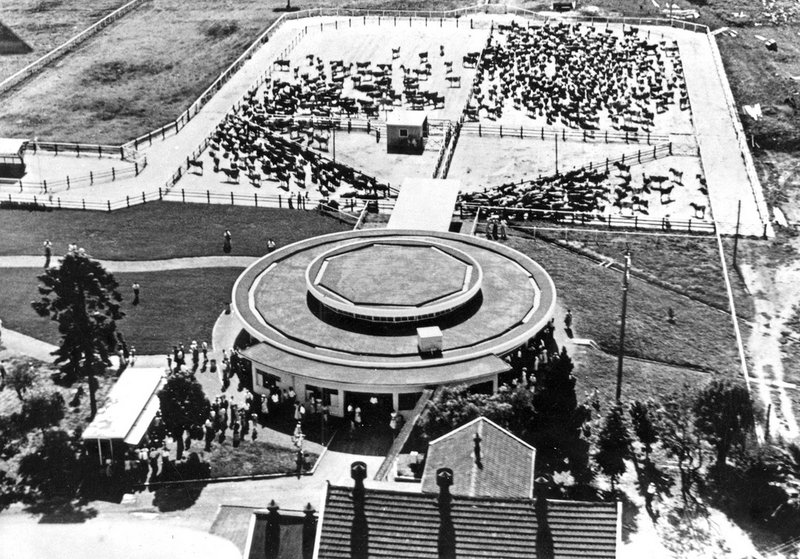
The Rotolactor
A rotolactor is a milking parlour or dairy that uses a rotating platform to milk a large number of cows in a short time. The idea was conceived in America in 1924 and the first rotolactor was built in New Jersey a few years later.
In the 1940s the manager of Camden Park Estate, Lieutenant-Colonel Edward Macarthur Onslow, inspected the American rotolactor while overseas on a business trip. After gaining information about its operation and costs, he returned home with enthusiasm to build a rotolactor on Camden Park at Menangle. It was the first in Australia and only the third of its kind in the world at that time.
The Camden Park House website describes the rotolactor as follows:
It was in effect a multi-cow rotary automatic milking machine 18.3 metres in diameter. Its whole circumference was enclosed with glass windows to give natural light, which was supplemented by artificial fluorescent tube lighting for early mornings and winter afternoons. The mechanism consisted of a circular platform mounted on roller bearing steel which rotated anti-clockwise on two circular rails resting on concrete walls 1.8 metres above the floor.
Normally with the 50 bails operating the rate was 300-375 cows an hour with ten operators. The 900 yard cows were mainly fed with concentrates and roughage from the irrigated acres of the Cowpasture Flats bordering the river. Each cow gave an average of 12.5 litres of 4.3 per cent butterfat milk. Menangle became the chief receiving depot ... during its heyday the rotolactor was a popular tourist attraction.
The rotolactor held 50 cows at the one time. Cows did one complete circuit and were fed while they were milked. They left the rotolactor at the same point as they started but via a different race so they could walk forward rather than reverse out.
Higher producing cows needed more time to be milked, so the rotolactor had three speeds: an eight minute rotation for low producers, a 10 minute lap for average producers and 12 minutes for high producers. Consequently the cows were split into three groups – the freshly calved cows in one, top producers in another, and cows at the end of their lactation in the third.
To assist identification, each cow wore a necklace and was fed according to its type. The highest producing cows wore a chain necklace and were given the most feed in the bails while being milked. The middle producers wore a white cord and received less. The lowest producers wore a green necklace and received the least concentrates in the bail.
The rotolactor was regarded as an Australian icon. In the 1950s and 1960s up to 2,000 visitors a week travelled to Menangle to see it in action and one estimate puts the number of visitors during its 20 years of operation under Macarthur ownership at over three million people.
The rotolactor closed in January 1977 and was unused for several years until Cork Investments sold the block of land on which it stood to a dairying family that traded as Halfpenny Hobbs Pty Ltd. The Halfpennys renovated and modified the rotolactor before reopening it for their own dairy. It finally closed about 1983.


